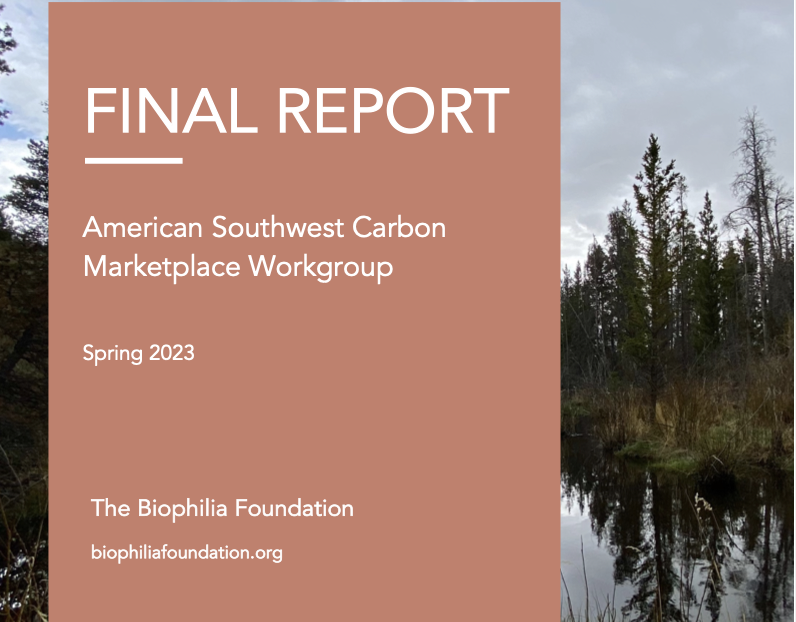Logo and Guidelines
Financing Watershed Restoration
Over the last several years, the Biophilia Foundation has worked to develop a carbon credit finance mechanism for dryland riparian restoration. This effort has included three components: research, review of opportunities with carbon registries, and convening an expert panel at the National Center for Ecological Synthesis and Analysis.
A Diversity of Benefits
A successful carbon credit mechanism for watershed restoration will provide a new source of revenue for this important activity, with an environmental impact that far exceeds the monetary value of sequestered carbon. Watershed restoration in drylands also provides water, food, and habitat for wildlife; cools the air and soil; restores hydrological function; increases resilience to drought and flooding; and potentially increases resilience to catastrophic wildfire. Every dollar invested through the carbon credit mechanism will be returned many times over.
Research
Little to no data are available on the impact of stream and watershed restoration on carbon sequestration. It is known that, generally, soils in warmer, dryer environments like the southwestern United States store less carbon than soils in more temperate, mesic environments. This generalization, however, does not take into account the verdant habitats that line healthy waterways in the southwest. Perennial and intermittent waterways in deserts and drylands support a diversity and abundance of plant species, including trees, shrubs, and understory plants, which store carbon in their tissues. As leaf litter decays into the soil, it increases soil carbon content, and wood and rock detention structures used for restoration trap new sediments, holding them in place and burying more carbon. Dead wood, too, is a highly stable form of carbon storage in arid environments. However, little is known about the extent to which carbon storage declines in degraded environments, nor how much or over what period carbon is stored upon restoration.
Biophilia is evaluating steps to close the knowledge gap and increase our understanding of soil carbon in degraded and restored waterways, and it has produced a protocol for soil sampling behind rock detention structures.
This work builds on Biophilia’s initial project to catalog the ways that process-based riverscape restoration can serve as a nature-based solution (see Gooden and Pritzlaff, 2021).
Carbon Registries
Biophilia partnered with Carbonomics, a carbon consultancy, to look for opportunities to use existing methods and protocols to generate carbon credits for stream and watershed restoration. An analysis found that registries’ protocols included some components that would quantify new carbon storage in restored areas. For example, forestry protocols could measure changes in woody biomass, but they would not be relevant where shrubs were climax vegetation, and they did not cover soil carbon. Similarly, grassland protocols could measure soil carbon, but permanently inundated soils, such as those that could result from restored waterways, are excluded from the metrics.
Biophilia and partners are currently discussing options for moving forward, including amending an existing protocol or applying to develop an entirely new protocol.
Carbon Marketplace Workgroup
Delivering a practical and efficient carbon credit mechanism for stream and watershed restoration requires scientific knowledge, practical experience, and advocacy. To bring these elements together, the Biophilia Foundation convened the American Southwest Carbon Marketplace Workgroup (ASCMW), including restoration practitioners, researchers, and policy experts from Utah, Colorado, Arizona, and New Mexico. Participants include:
-
- Gita Bodner, The Nature Conservancy of Arizona
- Greg Costello, Wildlands Network
- Jennifer Gooden, Biophilia Foundation
- Kris Hulvey, Working Lands Conservation
- Aaron Lien, University of Arizona
- Todd Lopez, Rio Grande Return
- Bre Owens, Western Landowners Alliance
- Richard Pritzlaff, Biophilia Foundation
- Nicole Rosmarino, Southern Plains Land Trust
- Rose Smith, Sageland Collaborative
The group convened for a year, initially at the National Center for Ecological Analysis and Synthesis in Santa Barbara and later in Park City and Santa Fe, to work on questions of science, practice, policy, finance, and governance of carbon credits.
The ASCMW final report includes highlights of lessons learned by the workgroup.
Read the final report from the American Southwest Carbon Marketplace Workgroup:
The Biophilia Foundation advances biodiversity conservation on private lands by fostering systemic change through people, their communities, and direct action.
Donate

